Nearly 12 Million Lost without Christ
4 Main Language Families of the Miao-Hmong
If you and others with your church, Sunday School, organization, or denomination would like to adopt an unreached Miao group for prayer, or if you would like to know how you can be involved in reaching them for Christ, contact miaoupg@gmail.com.
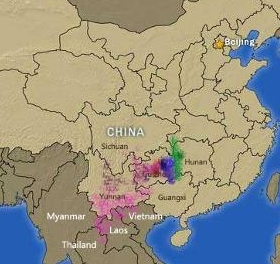
THE MIAO-HMONG number 12 million worldwide, more than 10 million of which live in China. They speak more than 80 languages, divided into four main language groups: Northern (Ghao-xong), Eastern (Qiandong), Western, and Farwestern.
"Hmong" is the name some languages call themselves, but others call themselves "Hmu" or other various names. The Chinese classification "Miao" refers to all Miao-Hmong groups, and means "rice seedling."
Several Farwestern Hmong groups have experienced church-planting movements during the past century, but most of the Miao still have little opportunity to hear the name of Jesus, indicated by the * next to their name. They are animists, living in fear of evil spirits, without any knowledge of the saving power of Christ to set them free.
Will you pray for them? Will you go to their lost lands?
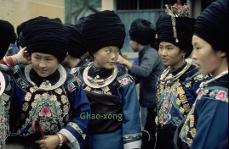
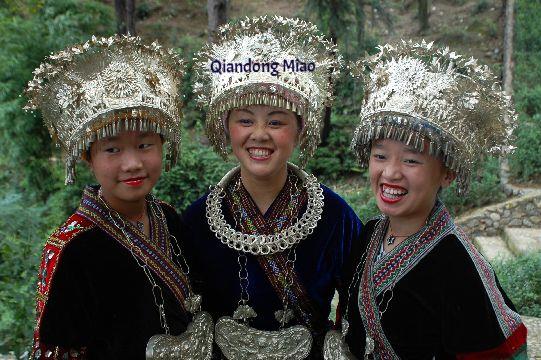
*Qiandong Miao
*Northern Qiandong Miao
*Eastern Qiandong Miao
*Southern Qiandong Miao
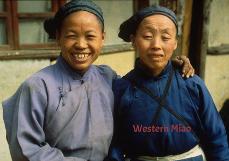
*Western Hmong
*Ge
*Guiyang Miao
*Huishui Miao
*Luobohe Miao
*Mashan Miao
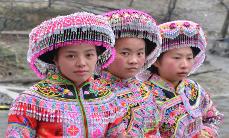
Farwestern Hmong
Gha-Mu
Horned Hmong
Sinicized Miao
White Hmong
Southern Hua Miao
*Northern Hua Miao
Hmong Boua
*The Ghao-Xong, about 1.1 million
Other names for the Ghao-Xong include the Northern Miao, the Xiangxi Miao, the Huayuan Miao, and the Red Miao

The Ghao-Xong
are divided into 2 main languages:
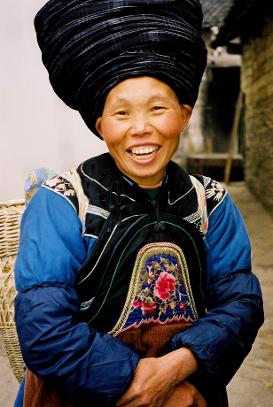
THE GHAO-XONG (pronounced “Gow-Shong”) are commonly called the Xiangxi Miao, and live mainly in western Hunan Province, where they farm in the high mountains.
They are divided into two mutually unintelligible languages, the Eastern and the Western Ghao-Xong.
Animists, they live in fear of evil spirits that must be appeased in the proper way and at the proper time. Festivals are often accompanied by vigorous drum dances, shamans climbing ladders of swords, men playing trumpets, and women dressed in elaborate outfits of silver and embroidery.
Missionaries served in this area from 1911 until they were forced out in 1949. Today, few Ghao-Xong have ever heard Jesus' name.
Gao-Xong man from western Hunan Province
The Eastern Ghao-Xong*, also called Eastern Xiangxi Miao, number about 100,000, and live mostly in western Hunan Province.
They are among the most unreached of all China's ethnic groups, and are considered an unengaged unreached people group, as no Christian materials exist in their language and no witness is known among them.
They rely heavily upon shamans to communicate between the human world and the spirit world. These shamans lead Ghao-Xong villagers to perform rituals to appease the spirits so no harm will come to their families.
- Lord, please raise up believers with a vision to reach the Eastern Ghao-Xong with the Gospel.
- Make a way for Your Word to be translated into the Eastern Ghao-Xong language.
- Give the Eastern Ghao-Xong a hunger for You, so when Your Word reaches them, they will receive it as truth.
- Make a way for Eastern Ghao-Xong who work in cities to meet Christians who will share the Good News with them. Open their hearts to receive You, and then give the new believers boldness and empowering by Your Spirit to take Your Gospel back to their home villages, sharing in their own language, until all the Eastern Ghao-Xong have a chance to hear about You.

Names:
Eastern Ghao-Xong
Eastern Xiangxi Miao
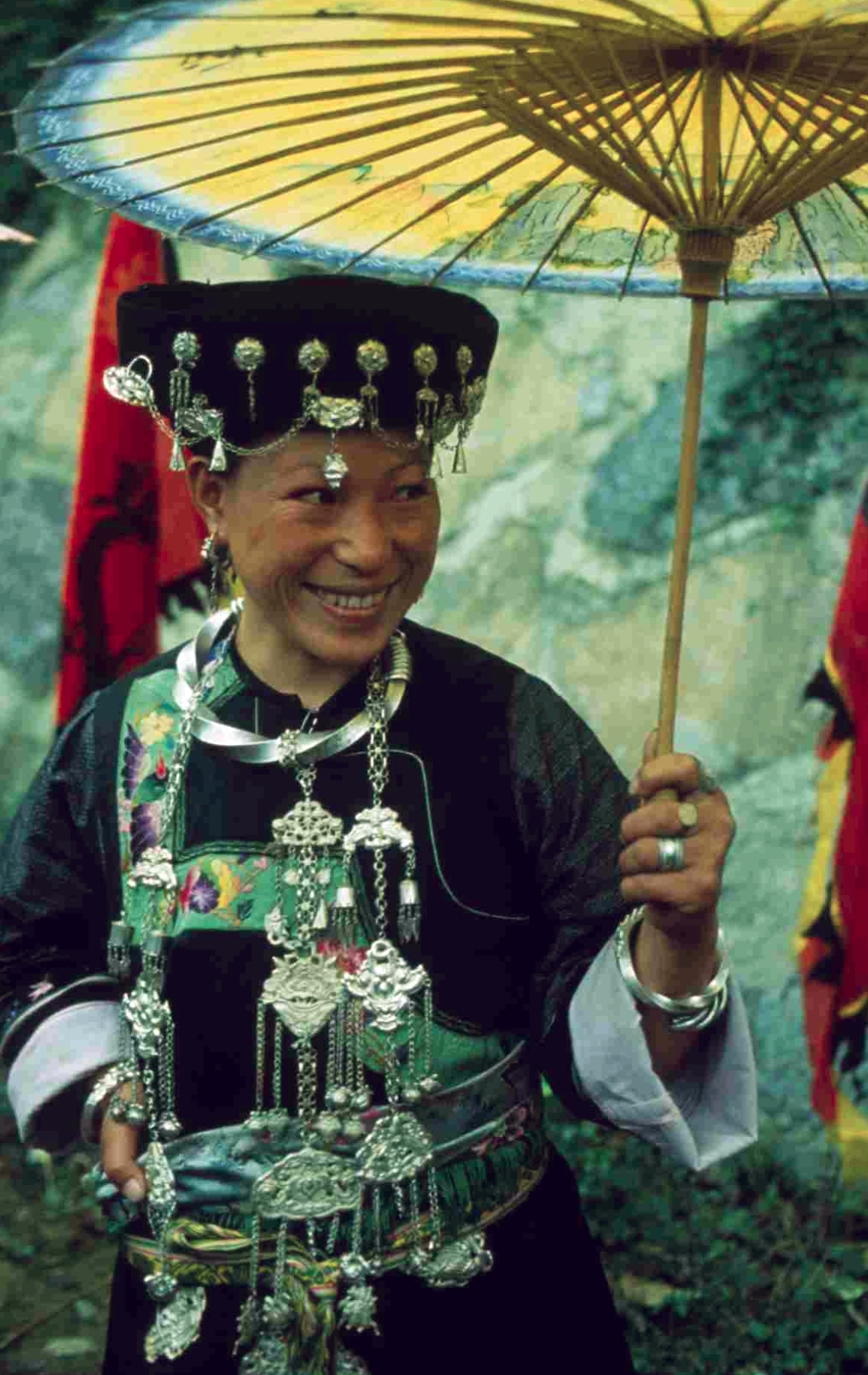
Ghao-Xong Miao woman in Jishou, Hunan Province
The Western Ghao-Xong*, also called Western Xiangxi Miao, number about 1 million, and live mostly in western Hunan province in China.
A few scattered recordings exist in their language, and some Western Ghao-Xong have had the opportunity to hear about Christ in recent years. But the vast majority still has yet to hear the Good News in a way they can easily understand.
They are a hearty people, making a living by farming on steep slopes, and some of their villages are still inaccessible except by winding, mountain foot paths.
- Lord, give the Western Ghao-Xong a hunger for Your truth, so they will lay down their spirit veneration to worship You alone.
- Protect believers living among and near the Western Ghao-Xong, please, Lord. Keep them safe from harm and persecution.
- Grow every Western Ghao-Xong believer strong in his/her faith, and give them boldness to share Your Good News with their families and neighbors.
- Raise up Ghao-Xong leaders who will shepherd Your flocks with love, truth, and Your Spirit's leadership.

Names:
Western Ghao-Xong
Western Xiangxi Miao
*The Qiandong Miao, about 2.6 million
Other names for the Qiandong Miao include Eastern Miao, Hmu, Black Miao, Southeast Guizhou Miao, Hei Miao, Qanu, Gha-nu

The Qiandong Miao
are divided into 3 main languages, within which are many dialects:
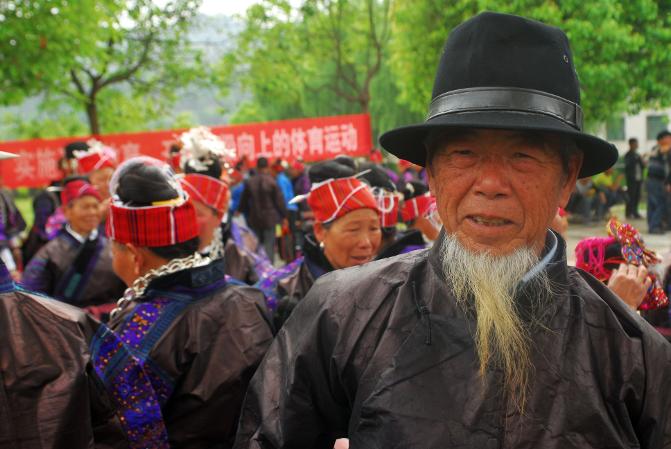
THE QIANDONG (pronounced “Cheean-dong”) Miao are mostly located in eastern Guizhou Province, China, and their dialects are so diverse that some cannot understand each other from one village to the next. Each dialect usually corresponds with a unique clothing style, making the Qiandong Miao one of the most colorful unreached people groups in all the world. They are known for their extravagant silver headdresses and intricately embroidered clothing, and for their singing, dancing, and lusheng-playing (A lusheng is a wind instrument made of bamboo).
The Qiandong Miao are divided into three main languages—the Northern, Eastern, and Southern Qiandong Miao. Within those are yet more dialects, usually named by the counties or villages they come from.
Missionaries who served in this area at the beginning of the 20th century were met with much persecution and hardship. Some were even martyred by the Miao. Today, many of the Qiandong Miao's hard-to-reach villages still have yet to hear God's name, much less that of His Son Jesus. They live in fear of evil spirits, appeasing them with sacrifices, offerings, and rituals ordered by the village shaman (see photo at left).
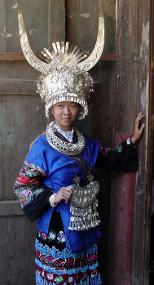
Northern Qiandong Miao woman from Xijiang Village.
The Northern Qiandong Miao*, also called Hmu, number about 1.6 million, and live mainly in 8 counties in the area around Kaili in eastern Guizhou Province, China.
They are known for their intricate embroidery and exquisite silver headdresses, both of which are needed for a young woman to be eligible for marriage. Traditionally, a mother's silver is passed down to her daughter, but in cases where families have more than one daughter, buying such extravagant silver for all the daughters may force a family into poverty.
The Northern Qiandong Miao are also known for their "flying songs." One mountaintop village might be several hours' walk from the next mountaintop village, so the Miao traditionally have projected their voices in loud song to share news with neighboring villages.
- Lord, please give the Northern Qiandong Miao such a hunger for You that they will seek You with all their hearts and find You.
- Grow every believer strong in You, and transform them by Your Spirit to walk in truth, love, purity, and boldness to share Your Good News.
- Lord, Your sheep are scattered and alone, sometimes the only believer in a village. Shepherd Your flock like only You can. Plant a church in every village, and be so near to each believer that all will feel Your presence, know Your voice, and follow You.
- Raise up Miao evangelists and pastors who abide in Your love, Your Word, and in Your Spirit, and who will lead Your people to also abide in You.
- Give Miao new believers the courage to lay down their spirit veneration to worship God alone. And raise up song-writers who will put the Word into Miao song, and project His praises and good News from every mountaintop.

Names:
Northern Qiandong Miao
Hmu
Black Miao
Hei Miao
Qanu
Gha-nu
Dialects are distinguished by varying clothing styles and named by villages or areas, such as
Huangping Miao
Shidong Miao
Kaili Miao
Gulong Miao
Taijiang Miao
Danzhai Miao
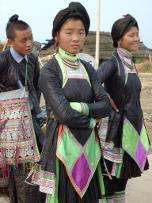
- Lord, we ask You to make a way where there seems to be no way for Your Word to be translated into the different Southern Qiandong Miao languages and dialects.
- Raise up believers with a vision to reach the Southern Qiandong Miao for You, Lord. Then gift them with Your Holy Spirit's empowering and an ability to speak the language so that Your Word will be preached in a way they can easily understand.
- Protect believers living or working among the Southern Qiandong Miao from any harm, and link them together to step out in faith to share Your Good News with the lost.
- Give the Southern Qiandong Miao such a hunger for You that they will travel far and wide to find You.
- Grow Southern Qiandondong Miao believers strong in You, and protect them from false teachings and cults.

Name:
Southern Qiandong Miao
Dialects are largely unresearched, but are usually distinguished by varying clothing styles and villages or areas, such as
Basha Miao
Baibei Miao
Ganlie Miao
Liangwang Miao
Wujia Miao
Gunzhong Miao
Gaowen Miao
Langdong Miao
Ma'an Miao
Guntang Miao
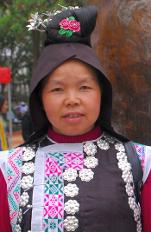
Eastern Qiandong Miao woman dressed for a festival.
The Eastern Qiandong Miao* number about 450,000, and are mostly located in fareastern Guizhou Province, where they farm and fish for a living.
Many of their villages are so isolated, they are only accessible by boat and footpath, making them one of the most unreached of all Miao groups.
Most Eastern Qiandong Miao have never heard of God, much less Christ, and their unresearched dialects and languages make it difficult to get the Word to them in a way they can easily understand.
They live in darkness and fear of evil spirits they believe will harm their families and homes if those demons are not appeased in the proper ways and at the proper times.
- Lord, we ask You to open up the way for Your truth to enter every Eastern Qiandong Miao village.
- Raise up Miao believers with a vision to reach the lost for You, and empower them with Your Spirit to share Your Good News in a way the lost can easily understand.
- Give the Eastern Qiandong Miao such a hunger for You that they will seek You with all their hearts and find You.
- Bring believers into the paths of those Eastern Qiandong Miao who work in cities, so they will hear Your Good News and believe in You; then return to their home villages to share.

Name:
Eastern Qiandong Miao
Dialects are largely unresearched, but may be distinguished by varying clothing styles and villages or areas
*The Western Hmong, about 950,000
Other names for the Western Hmong include Western Miao and Central Miao

The Western Miao
are divided into 5 main languages, within which are many languages and dialects:
THE WESTERN MIAO/HMONG are mainly located in the rocky, cone-shaped mountain slopes of Central Guizhou Province, China.
They are an animistic people, who believe in spirits that inhabit mountains, certain bridges and trees, and other strategic places surrounding their villages. Their many, varied languages have isolated them from the Gospel. But in recent years, as more and more roads open, many Western Miao have left their villages to find work in cities like Guiyang, Guizhou's capital.
None of their many languages have a Bible, and most don't even have a writing system. Some of these tribes, in fact, have no known Christian witness among them, making them among China's most unreached people groups.
Many of their villages are so poor, Miao must walk several hours just to bring water home to their families. Winters are harsh, without enough heating, blankets, or clothes to keep a family warm.
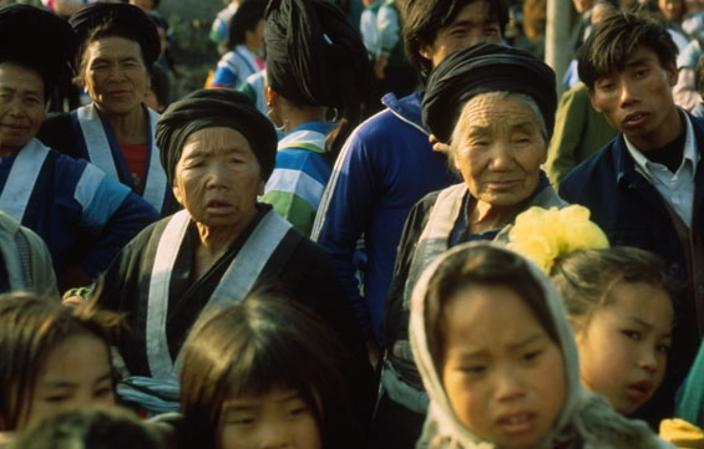
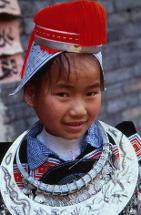
A Ge girl ornamented with silver for a festival
The Ge* (pronounced "Guh"), also called Gejia, number about 100,000, and are located mainly in Huangping County, Guizhou, nested among Northern Qiandong Miao villages there.
Although the Ge speak a Western Hmongic language, they consider themselves a completely different people group from the Miao. Legend says a Miao woman fell in love with a Han warrior, but their marriage was forbidden, so they ran away together and began the Ge nationality. In honor of the soldier, Ge women today wear batik hats and clothes that resemble a helmet, breastplate, and armor.
Some Bible stories, Gospels, and other materials exist in their language, but the few Ge Christians have been persecuted by neighbors and authorities.
- Lord, we ask for Your protection over all believers living and working among the Ge. Keep their hearts steadfast in You, no matter what they face, and multiply Your church each time someone is persecuted.
- Open a way for Your Word to go in power into every Ge village.
- Give the Ge a hunger for You, Lord, so that when they hear Your Good News, they will bow and worship You alone.
- Gather believers together into churches, Lord. Then call them out to plant more Ge churches, until all the Ge have heard of the God Who loves them and gave His Son to die for their sins so they can be saved.

Names:
Ge
Gejia
Chonganjiang Miao
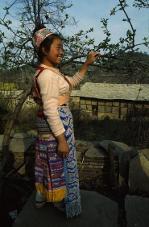
A Guiyang Miao girl from Huaxi, Guizhou
The Guiyang Miao* (pronounced "Gway-Yahng") number about 240,000, and are located in the areas surrounding Guiyang City, the capital of Guizhou Province in China.
They are mainly farmers, but in recent years, many of their villages have emptied, as Miao seek work in Guiyang and other cities.
In the past, many Guiyang Miao could not speak Chinese, but this situation is changing as more and more roads are built, connecting their villages to civilization.
No Bible exists in any of their three main languages, which are still largely unresearched. In fact, only a handful of Christians are known among the Guiyang Miao.
- Lord, ground believers strong in You, and give them a vision to take Your Good News to every Guiyang Miao village.
- Make a way for Scripture to be planted in Guiyang Miao hearts. Raise up believers who will create a writing system for the Guiyang Miao and translate the Word.
- Give the Guiyang Miao such a hunger for You that they will travel far and wide to find someone who will tell them the Good News.
- As Guiyang Miao travel to cities, Lord, bring into their paths those who can share with them the Good News in a way they can easily understand.

Divided into three main languages:
Northern Guiyang Miao
Southern Guiyang Miao
Southwestern Guiyang Miao
Languages and dialects within those languages are distinguished by varying clothing styles, villages, and areas
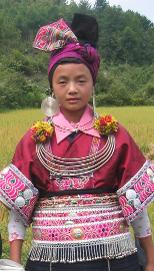
A Huishui Miao woman from Yarong, Guizhou
The Huishui Miao* (pronounced "Hway-shway") number over 230,000, and live mainly in Huishui County, Guizhou Province, China, and are divided into at least four languages, each of which are unwritten and largely unresearched.
No Bible exists in any of their languages, and up until recently, no known believers existed among the Huishui Miao. They have been largely untargeted by Christians, but more and more roads are making access to their villages easier. In addition, some Huishui Miao have moved to cities to find work.
Like all Miao/Hmong groups, the Huishui Miao love to sing and dance, and their clothing styles vary according to location and language.
They live in fear of evil spirits, without any knowledge of the God Who loves them and gave His Son to die for them.
- Lord, we thank You for the Huishui Miao man who came to You recently. Please grow him in his faith and give him a burden to see others come to know You. Give him courage to share with his lost neighbors and family members.
- We ask You, Lord, to perform a miracle and plant a church in every Huishui Miao village. Raise up believers with a vision to see Your Gospel permeate all of Huishui.
- Give the Huishui Miao such a hunger for You that they will seek You and find You. Open the eyes of their hearts so they can see You as You truly are.
- Raise up believers with a burden to reach the Huishui Miao for You, willing to do whatever it takes for the lost to hear the Good News in a way that they can easily understand.

Languages and dialects are largely unresearched, but may be distinguished by clothing styles and villages or areas
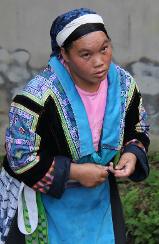
A Luobohe Miao woman in traditional clothing
The Luobohe Miao* (pronounced "Lwo-boh-huh") number about 77,000, and are located in counties east of Guiyang City, and are among the most unreached of all China's peoples, as no believers are targeting them with the Gospel message.
Their language is unwritten and largely unresearched, and no Scripture or any other Christian materials exist in Luobohe Miao. Only one believer is known among them.
They are an animistic people who worship spirits and rely on the village shaman to communicate with the spirit world in order to heal the sick and prevent disaster from coming to their families.
- Lord, make a way for Your Word to enter every Luobohe Miao village with power.
- Open up the hearts of the Luobohe Miao to receive Your Good News with joy whenever they hear Your name. Lift the veil from their eyes so they can see You as You truly are.
- We ask You, Lord, to disciple and grow this one believer. Give her courage to share Your Good News with her neighbors and family. And provide a way for her to connect with other believers. Plant a church in her village, Lord.
- Raise up believers with a burden to see all the Luobohe Miao come to You, and give them Your vision for how to do that.
- Make a way for Your Word to be translated into the Luobohe Miao language.

Names:
Luobohe Miao
Luobo River Miao
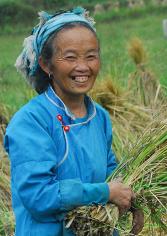
A Central Mashan Miao woman harvests rice in a village near Ziyun, Guizhou Province
The Mashan Miao* (pronounced "Mah-shahn") number about 160,000, and live mostly in the vicinity of Mashan County and adjoining counties of Guizhou Province in China.
They are divided into at least four main languages, all of which are unwritten and have no Scripture portions at all.
The Mashan Miao are among China's poorest peoples. The terrain where they live and farm is rocky and difficult. Some Mashan Miao must walk five hours just to fetch water for their families.
Their life is harsh and filled with fear of evil spirits. Still untargeted by Christians, they remain one of the neediest unreached people groups in all of China.
- Lord, call out believers with a heart for the Mashan Miao who will have the courage and empowering by Your Spirit to do whatever it takes to reach their lost villages for You.
- Set the Mashan Miao free from their fear and sin, Lord. Frustrate the shamans and show the Miao that their efforts to appease the demons are useless. Then give them a hunger for the One True God.
- Open the hearts of the Mashan Miao to receive You with joy whenever they hear the Good News. Even now, till the soil of their hearts, preparing them for the seeds of the Gospel that You will plant there.
- Move the hearts of believers living near the Mashan Miao to reach them with the Good News.

Divided into four main languages:
Northern Mashan Miao
Southern Mashan Miao
Western Mashan Miao
Central Mashan Miao
The Farwestern Hmong, about 3.5 million
Other names for the Farwestern Hmong are included under each of the languages below
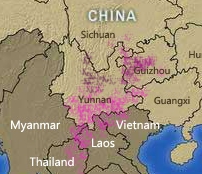
The Farwestern Hmong
are divided into several languages, within which are other languages and dialects:
(Right) A church in a White Hmong village in northern Thailand, and young Hmong boys wrestling (above right).
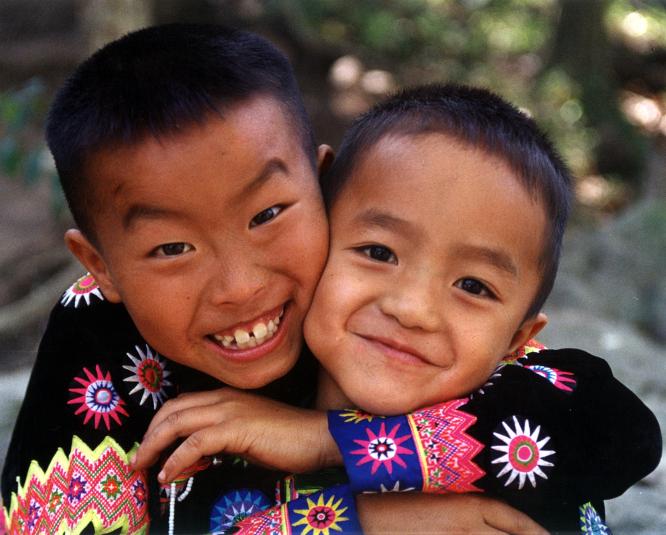
THE FARWESTERN HMONG (pronounced “mong,” only blow out your nose before you say the “m”) live mainly in China, Vietnam, Laos, Thailand, and Myanmar. After the Vietnam War, thousands of White and Blue Hmong were relocated to countries like the United States, France, French Guiana, Argentina, and Canada as refugees.
Unlike the other language groups of the Miao, most of the Farwestern Hmong not only have a witness among them, but have turned to the Lord by the thousands, due to missionary work (see Short History of Missions for the Miao of China), the mass exodus of Hmong to free countries after the Vietnam War, and radio broadcasts in recent years. In fact, at least three Farwestern languages now have the whole Bible, and some Hmong tribes have seen church planting movements among them. At least two of the Farwestern language groups have begun sending missionaries to other unreached people groups, both Miao and other minorities.
But thousands of Farwestern Hmong still have never heard Jesus' name, especially in isolated areas of China. Others in Thailand, China, and other countries have heard of Christ but chosen not to follow Him. They live in fear of evil spirits and in desperate need of a Savior to set them free.
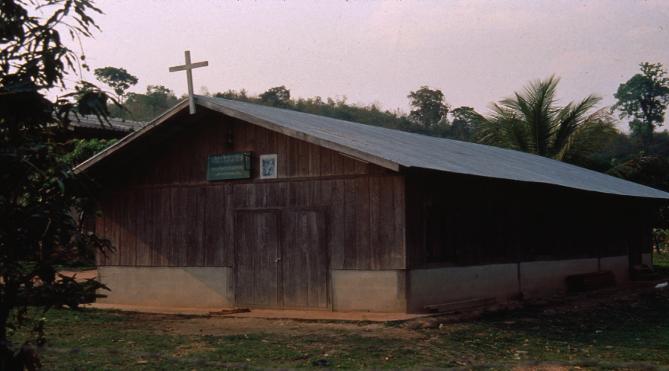
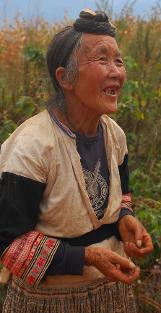
A Big Flowery Miao woman in Yunnan Province, China
Commonly called the Big Flowery Miao, the A-Hmao (pronounced "Ah-Hmow) number nearly 400,000 and live mainly in central Yunnan and western Guizhou, China.
About a century ago, a powerful movement of God happened among this tribe, as thousands turned to Christ. (See Short History of Missions for the Miao of China) Missionary Samuel Pollard developed a writing system for the A-Hmao and translated the New Testament. Now, the Big Flowery Miao themselves have completed the Bible translation with the Old Testament.
Their multi-harmony choirs have become famous throughout China, and even throughout the world. But the most amazing transformation of this people group has been in their hearts, where they have found freedom from fear of evil spirits. With no more need to offer sacrifices, their homes are also less poor and filled with joy.
- Lord, thank You for the amazing things You've done among the A-Hmao.
- Raise up believers grounded in Your truth, who will cross over language and cultural barriers to take Your Good News to those who have yet to hear.
- Bless the A-Hmao and protect them from harm. Let everyone around them see Your hand upon them and long to know the God of Love.
- Wherever there is dissension in the church, Lord, bring unity and understanding.
- Still some A-Hmao villages exist that have never heard Your name. Please, Lord, give them a hunger for You, and then bring Your Word to them in power.

Names:
A-Hmao
Big Flowery Miao
Large Flowery Miao
Da Hua Miao
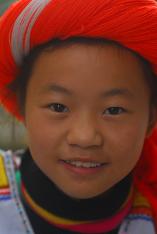
The Gha-Mu (pronounced "Gah-Moo"), also commonly known as the Small Flowery Miao, number about 108,000, and live mostly in western Guizhou.
Their language is mutually unintelligible with that of the Large Flowery Miao or any of the other Farwestern Hmong groups.
Due to missionary efforts a century or so ago, more than a quarter of this tribe believe in Christ today. But no Bible exists in their language, and still many villages have never heard Jesus' name.
In recent years, however, some believers have caught a vision for reaching the lost, and have even begun crossing into other people groups to share the Gospel.
- Lord, we ask You for a powerful movement of revival among the Gha-Mu, such that any believers who have only been nominal in their faith will resurrect with passion for You.
- Make a way for Your Word to be translated into their language.
- Raise up "home" missionaries among the Gha-Mu, who will take Your Good News to the many villages that still have not heard Your name.
- Make Gha-Mu believers a people known for their love, and shine the light within them to all the dark corners around them, until everyone has believed in You.
- Give lost Small Flowery Miao a hunger for You so strong, they will travel far to find You.

Names:
Gha-Mu
Small Flowery Miao
Xiao Hua Miao
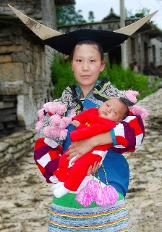
The Horned Miao are also called Hmong Vrong, and number about 80,000, located mostly in Western Guizhou Province.
They are named for their interesting headdresses that resemble the horns of a water buffalo.
They are animists, who believe in spirits that inhabit mountains, bridges, doorposts, trees, and other areas around their villages.
In recent years, many Horned Miao have come to faith in Christ, and several churches have been planted among them, with the Horned Miao themselves taking on the task to reach all their villages for Christ.
Still no Bible exists in their language, however, and many villages have yet to hear Jesus' name.
- Lord, make a way for Your Word to be translated into Hmong Vrong.
- Grow believers strong in You, and gift them with Your Spirit's empowering to boldly share Your Good News with the lost in a way they can easily understand.
- Give the lost Horned Miao a hunger for You, and till the soil of their hearts so that when they hear Your Good News, they will receive You with open arms.
- Use the Horned Miao to be a light to the lost peoples all around them. May they be known for their love, as they bring You glory in an area where so many altars to the evil one stand.

Names:
Horned Miao
Hmong Vrong
Jiaojiao Miao
Qing Miao
Forest Miao
Longhorn Miao
Changjiao Miao
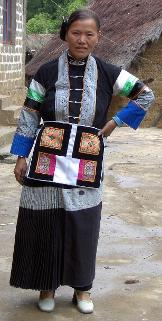
The Sinicized Hmong are also commonly known as the Han Miao or Hmong Shua.
They live mostly in western Guizhou, where they farm the rocky mountain slopes. Their varying clothing styles indicate the villages or areas they are from, and often reflect variations in dialect.
Several churches exist among them, but the Bible has not yet been translated into their language. And still many of their villages have yet to hear the Good News.
Their language contains many borrowed words from Chinese, but still is mutually unintelligible from Chinese or other Miao languages.
- Lord, give the Sinicized Miao a hunger for You. Prepare the hearts of the lost so that when Your Good News comes to them, they will receive You with open arms.
- Grow believers strong in You. Give them a hunger to study Your Word, meet together, and worship You.
- Ground believers in Your truth so no cults or false teachings will lead them astray.
- Bring revival to their churches, Lord, and give them a vision to reach out to the lost.
- Wherever there is dissension among believers, Lord, please bring understanding, restoration, unity, forgiveness and love.
- May the Sinicized Hmong believers be known by their love and devotion to You, Lord. May their warmth and kindness become so contagious that the lost all around them will be drawn to You through them.

Names:
Sinicized Hmong
Han Miao
Hmong Shua
Hmong Sa
Hmong Nzi
Man Mong
Waishu Miao
Lopsided Comb Miao
Mushu Miao
Wooden Comb Miao
Shuixi Miao
Chanxhu Miao
Longcomb Miao
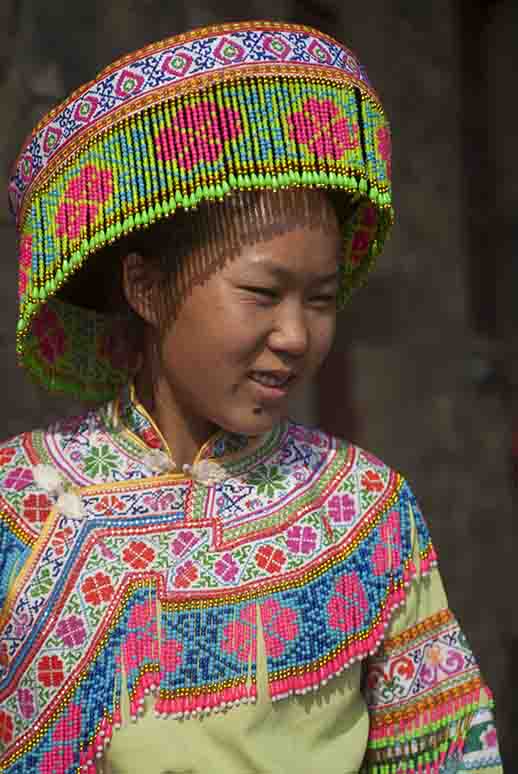
White Hmong woman in an unreached village in western Guizhou, China
The White Hmong, also known as Hmong Daw, live mostly in southern Yunnan, western Guizhou and western Guangxi Provinces in China, and also in the countries of Laos, Vietnam, Thailand, and Myanmar.
After the Vietnam War, many White Hmong sought asylum in countries such as the United States, France, Argentina, Australia, and French Guiana. In the United States, thousands were taken in by churches that shared with them God's love.
White Hmong believers translated the Bible into their own language, and through radio broadcasts in Asia, have been able to spread the Good News so widely that thousands of White Hmong in closed countries have come to Christ in recent years.
These Hmong have been persecuted severely for their faith by oppressive governments. And in recent years, a new threat has arrived in their villages, as false cults have stolen over half of the believers.
- Lord, even though so many White Hmong now believe in You, still so many villages have yet to hear Your Good News. Give the lost a hunger for You so that when they hear Your truth, they will accept You with open arms.
- Ground every White Hmong believer in truth and in love.
- Gentle Shepherd, guide back into Your fold those who have been stolen away by cults and false teachings.
- Make Your Word available to every White Hmong in a way that they can listen to it or read it every day, so they will know the truth and the truth will set them free.
- Protect believers from persecution, and give them comfort and peace even through the most difficult of times.
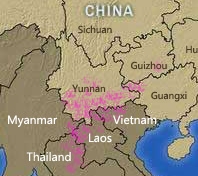
Names:
White Hmong
Hmong Daw
Qua Mpa
Bai Miao
Meo Kao
Meo Do
Red Hmong
Striped Hmong
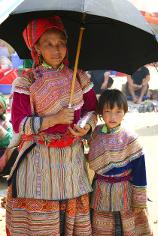
A Hmong Leng woman and child at market
The Southern Hua Miao are also commonly called the Blue Hmong, Hmong Leng, or Hmong Njua. They live mostly in southern Yunnan, western Guangxi, and western Guizhou Provinces in China, as well as in the countries of Vietnam, Laos, Thailand and Myanmar.
Like the White Hmong, the Blue Hmong also fought in the Vietnam War and sought refuge in countries like the USA, France and French Guiana.
Through the loving care of churches in the United States, and radio broadcasts in their own language in Asia, thousands of Blue Hmong have turned to the Lord, although many of the new believers in Asia have succumbed to false cults in recent years.
The entire Bible exists in their language, but Christians living in closed countries have been persecuted severely for their faith.
- Lord, please open up the way for every Southern Hua Miao to hear Your word and receive You. Give the lost a deep hunger for Your Word; then lead them to radio broadcasts, believers or other ways to hear about You.
- Raise up strong Southern Hua Miao evangelists, pastors, teachers and leaders who will walk in purity, love, truth and in Your Spirit every moment.
- Grow Your church among the Southern Hua Miao, even in the midst of persecution. Draw them close to You, and make them a light to all around them.
- For those who go through persecution, Lord, please wrap Your arms around them and let them feel Your presence and peace.
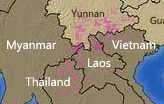
Names:
Southern Hua Miao
Blue Hmong
Green Hmong
Hmong Leng
Hmong Njua
Mong Shi
Mong Si
Mong Hoa
Red-headed Hmong
Green Meo or Miao
Flowery Meo or Miao
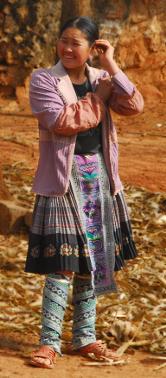
A Hmong Sao woman in southern Yunnan
- Lord, please give the Northern Hua Miao a hunger for You, so that when they hear Your Good News, they will receive You with open arms.
- Place a shield of protection around every believer living among the Hmong Sao or sharing Christ with them, and keep them safe from persecution, surveillance, illness and harm.
- Make a way for the Word to be translated into their language, and raise up Northern Hua Miao believers with a burden to reach their own people for You.
- Replace their fear with Your love, Lord. Write Your name on their hearts.

Names:
Northern Hua Miao
Hmong Sao
Hmong Sou
Hmong Be
Dananshan Miao
Chuanqiandian Miao
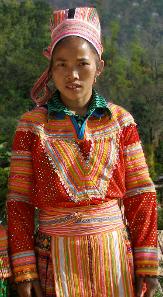
Hmong Boua woman in Yunnan Province, China
The Hmong Boua (pronounced "Boo-ah") live mostly in China's Yunnan Province, and in the countries of Vietnam and Myanmar.
An animistic people, the Hmong Boua venerate spirits and live in fear of them. Their language is similar to other Hua Miao languages, and Scripture is in the process of being translated for them.
In recent years, a movement of God has begun among these Hmong, mainly through radio broadcasts, and about 27 churches have emerged.
But still so many Hmong Boua have yet to hear the Good News.
- Lord, please raise up leaders from among the Hmong Boua who will be grounded in Your truth. Fill them to overflowing with Your Spirit to lead Your people well.
- Be with those doing the radio broadcasts and leadership trainings, Lord. Protect them from any harm or persecution.
- Surround churches and believers with Your love. Comfort them and give them peace when trials come. Protect them from those who would seek to harm them for their faith.
- Grow the new believers strong in You, Lord, with deep roots in Your Word, so they will bear much fruit and not succumb to false teachings or cults.
- Give lost Hmong Boua a hunger for You.

Names:
Hmong Boua
Black Hmong
*Other Miao-Related Unreached People Groups
THE MIAO have such a long history, dating back more than 4000 years, that persecution, wars, geographic isolation, oppressive governments, and many other factors have divided them off into many different languages and identities.
Some Miao who moved into Han areas have taken on the local dialects of Chinese, and others who live near the Dong or the Yao-Mien have taken on those minority languages.
The Bunu (not presented in this website) are considered ethnically Yao, but they speak a Western Hmongic language.
In this section, we will attempt to present several ethnically-related Miao groups that are highly unreached, but that don't fit into the Four Main Miao Language Groups.
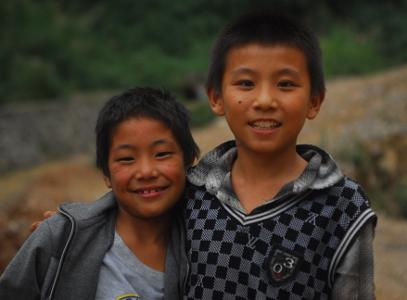
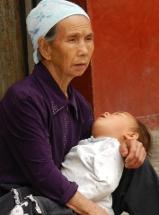
An Aoka grandma and baby in western Hunan Province, China
The Aoka* (pronounced "Aow-kah") number about 252,000 and live mainly in southwestern Hunan Province, bleeding into northern Guangxi Province in China.
Their language and culture is largely unresearched, but seems to have assimilated into a Xiangic (Hunan) Chinese dialect.
Some Christian work has been done among them in the past, but few believers exist, and most Aoka have never heard the Good News.
- Lord, please call out believers who will have a burden to take the Good News to the Aoka in a way they can easily understand. Prepare the way even now for these evangelists to be well-accepted by the Aoka.
- Till the soil of Aoka hearts, so that when the Good News is presented to them, they will receive it with joy.
- Bring Christians in contact with Aoka who have traveled to cities to find work, and then as those Aoka come to You, urge them to take the message back to their villages.
- Grow Aoka believers strong in You. May they be known for their faith, love and hope.

Name:
Aoka
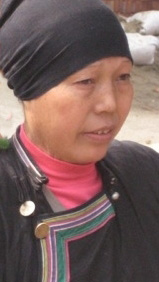
A Cao Miao woman in Liping, Guizhou Province
The Cao Miao* (pronounced "Tsow") are also called the Mjuniang, and number about 75,600. They live mainly in Liping County, southeastern Guizhou Province, China.
Although ethnically Miao, their language resembles that of their Southern Dong neighbors, but they are considered a separate people group.
The Cao Miao worship spirits and ancestors, and trust in the village shamans to guide them in subduing the anger of these spirits through sacrifices and rituals.
They are untargeted by Christians for ministry, making the Cao Miao one of the most unreached peoples in all of China.
- Lord, we ask You to make a way where there seems to be no way for Your Word to spread to every Cao Miao village.
- Give them a hunger for You, and raise up believers who will learn their language and take the Good News to them.
- Protect and bless every believer living near the Cao Miao to grow deep in the Lord, such that His love shines through them, drawing lost Cao Miao to You.
- Give Dong and Han believers a vision to cross cultural and language barriers to reach the Cao Miao for You.

Names:
Cao Miao
Grass Miao
Mjuniang
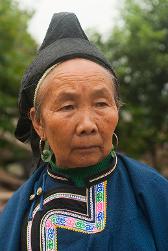
A Laba Miao woman in western Guizhou
The Laba* (pronounced "Lah-bah") number nearly 250,000, and are located mostly in western Guizhou province’s Qinglong, Shuicheng, Pu’an, and Panxian counties.
Although they speak a local dialect of Mandarin Chinese, the Laba see themselves as a separate people group from the Han. They share many of the characteristics of their Miao neighbors, including a Miao word here and there.
The Laba worship the spirits of their ancestors, and sacrifice a cow every three years for the ancestors to eat in the after life.
Because of the witness of their Large Flowery Miao neighbors, the Gospel has reached a small group of Laba in one location. Those in surrounding villages see Christianity as something only for the literate, however, not for the majority of Laba who can’t read or write.
- Lord, please give the Laba a hunger for the One True God, such that they travel to neighboring villages to ask about Christ.
- Raise up Laba believers with a vision to reach every Laba village with the Gospel.
- Ground every believer in truth and love, so they will not be led astray by false teachings or cults.
- May Laba believers be known so widely for their love that Your light in them will draw them to You like moths to a flame.

Names:
Laba
Laba Miao
Huguang

Liupanshui Miao woman in western Guizhou
The Liupanshui Miao* (pronounced "Lyoo-pahn-shway") number about 61,615, and live mainly in Liupanshui County of western Guizhou Province, China.
They are farmers presumed to have migrated to their present location from western Hunan province, where a Chinese language called “Xiang” is spoken.
Animists, the Liupanshui Miao are untargeted by Christians for the spread of the Gospel and most have never heard the name of Christ, making them an unengaged unreached people group.
- Lord, please call out believers with a heart for the Liupanshui Miao, who will settle in their villages and towns for the purpose of being Your light in the darkness there.
- Give Liupanshui Miao such a hunger for You that they will search for You and find You.
- Whenever Liupanshui Miao search for the truth, Lord, put them in contact with Christians, Christian radio broadcasts, Bibles, tracts or some other way they can receive Your truth.
- May Your kingdom come among the Liupanshui Miao!

Names:
Liupanshui Miao
Lupanshui Miao